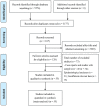Clinicopathological characteristics of 8697 patients with COVID-19 in China: a meta-analysis
- PMID: 32371463
- PMCID: PMC7229787
- DOI: 10.1136/fmch-2020-000406
Clinicopathological characteristics of 8697 patients with COVID-19 in China: a meta-analysis
Erratum in
-
Correction: Clinicopathological characteristics of 8697 patients with COVID-19 in China: a meta-analysis.Fam Med Community Health. 2020 May;8(2):e000406corr1. doi: 10.1136/fmch-2020-000406corr1. Fam Med Community Health. 2020. PMID: 32448784 Free PMC article. No abstract available.
Abstract
Objective: Our study aims to present a summary of the clinicopathological characteristics of patients affected by the coronavirus disease 2019 (COVID-19) that can be used as a reference for further research and clinical decisions.
Design: Studies were included in the meta-analysis if they had cohort, case-control or case series designs and provided sufficient details on clinical symptoms, laboratory outcomes and asymptomatic patients.
Setting: PubMed, Embase, Chinese Biomedical Literature Database, Wanfang, China Science and Technology Journal Database and China National Knowledge Infrastructure databases were electronically searched to identify related studies published between 1 January 2020 and 16 March 2020. Three reviewers independently examined the literature, extracted relevant data and assessed the risk of publication bias before including the studies in the meta-analysis.
Participants: The confirmed cases of COVID-19.
Results: A total of 55 unique retrospective studies involving 8697 patients with COVID-19 were identified. Meta-analysis showed that a higher proportion of infected patients were male (53.3%), and the two major symptoms observed were fever (78.4%) and cough (58.3%). Other common symptoms included fatigue (34%), myalgia (21.9%), expectoration (23.7%), anorexia (22.9%), chest tightness (22.9%) and dyspnoea (20.6%). Minor symptoms included nausea and vomiting (6.6%), diarrhoea (8.2%), headache (11.3%), pharyngalgia (11.6%), shivering (15.2%) and rhinorrhea (7.3%). About 5.4% of the patients were asymptomatic. Most patients showed normal leucocyte counts (64.7%) and elevated C reactive protein levels (65.9%). Lymphopaenia was observed in about 47.6% of the infected patients, along with abnormal levels of myocardial enzymes (49.4%) and liver function (26.4%). Other findings included leucopenia (23.5%), elevated D-dimer (20.4%), elevated erythrocyte sedimentation rate (20.4%), leucocytosis (9.9%), elevated procalcitonin (16.7%) and abnormal renal function (10.9%).
Conclusions: The most commonly experienced symptoms of patients with COVID-19 were fever and cough. Myalgia, anorexia, chest tightness and dyspnoea were found in some patients. A relatively small percentage of patients were asymptomatic and could act as carriers of the disease. Most patients showed normal leucocyte counts, elevated levels of C reactive protein and lymphopaenia, confirming the viral origin of the disease.
Keywords: communicable disease control.
© Author(s) (or their employer(s)) 2020. Re-use permitted under CC BY-NC. No commercial re-use. See rights and permissions. Published by BMJ.
Conflict of interest statement
Competing interests: None declared.
Figures





Comment in
-
Clinicopathological characteristics of 8697 patients with COVID-19 in China: meta-analysis.Fam Med Community Health. 2020 May;8(2):e000488. doi: 10.1136/fmch-2020-000488. Fam Med Community Health. 2020. PMID: 32467096 Free PMC article. No abstract available.
References
-
- WHO Who Director-General's opening remarks at the media briefing on COVID-19 -11. Available: https://www.who.int/dg/speeches/detail/who-director-general-s-opening-re... [Accessed 29 Mar 2020].
-
- WHO Coronavirus disease(COVID-19) outbreak situation. Available: https://www.who.int/emergencies/diseases/novel-coronavirus-2019 [Accessed 29 Mar 2020].
-
- WHO Coronavirus disease 2019 (COVID-19)Situation Report-67). Available: https://www.who.int/docs/default-source/coronaviruse/situation-reports/2... [Accessed 29 Mar 2020].
-
- WHO Naming the coronavirus disease (COVID-19) and the virus that causes it. Available: https://www.who.int/emergencies/diseases/novel-coronavirus-2019/technica... [Accessed 29 Mar 2020].
Publication types
MeSH terms
LinkOut - more resources
Full Text Sources
Research Materials
